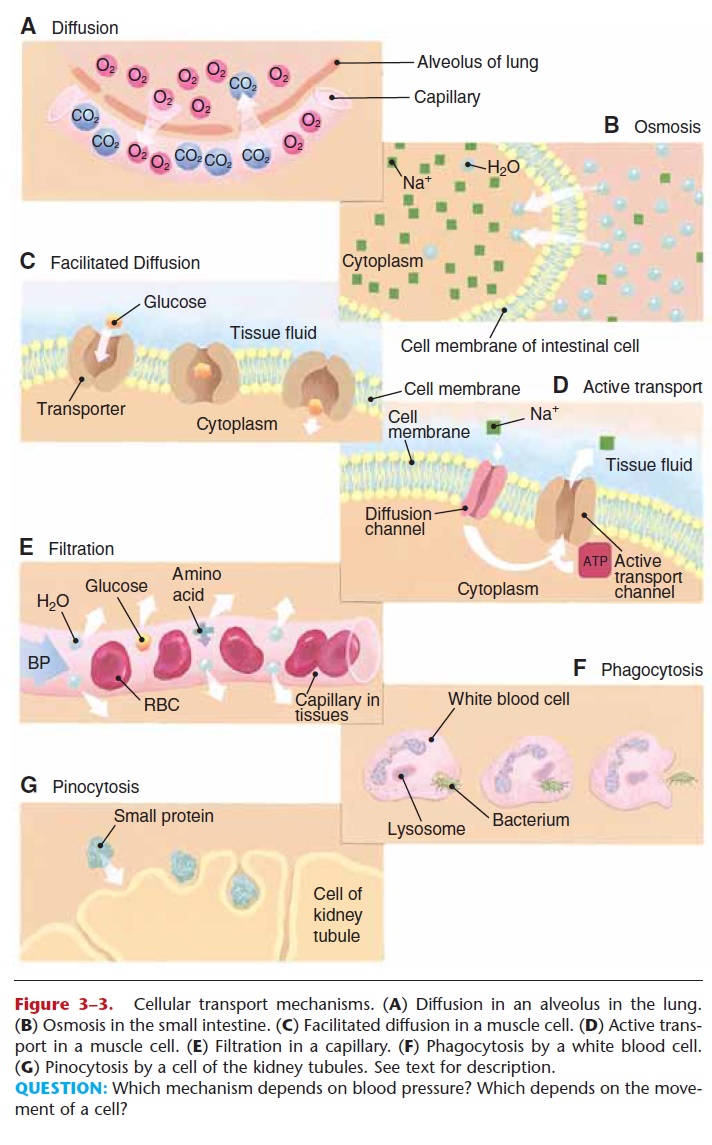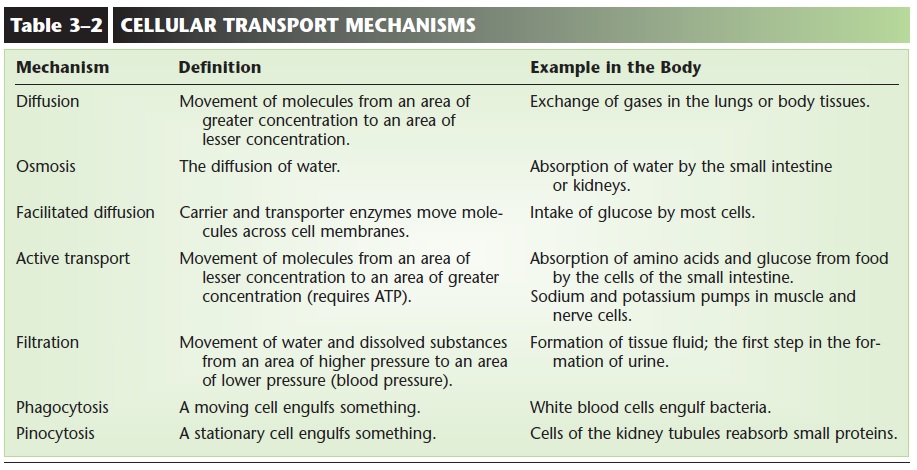Chapter: Essentials of Anatomy and Physiology: Cells
Cellular Transport Mechanisms
CELLULAR TRANSPORT MECHANISMS
Living cells constantly interact with the blood or tis-sue fluid around them, taking in some substances and secreting or excreting others. There are several mech-anisms of transport that enable cells to move materials into or out of the cell: diffusion, osmosis, facilitated diffusion, active transport, filtration, phagocytosis, and pinocytosis. Some of these take place without the expenditure of energy by the cells. But others do require energy, often in the form of ATP. Each of these mechanisms is described in the following sec-tions and an example is included to show how each is important to the body.
DIFFUSION
Diffusion is the movement of molecules from an area of greater concentration to an area of lesser concen-tration (that is, with or along aconcentration gradi-ent). Diffusion occurs because molecules have free energy; that is, they are always in motion. The mole-cules in a solid move very slowly; those in a liquid move faster; and those in a gas move faster still, such as when ice absorbs heat energy, melts, and then evap-orates. Imagine a green sugar cube at the bottom of a glass of water (green so that we can see it). As the sugar dissolves, the sugar molecules collide with one another or the water molecules, and the green color seems to rise in the glass. These collisions spread out the sugar molecules until they are evenly dispersed among the water molecules (this would take a very long time), and the water eventually becomes entirely green. The molecules are still moving, but as some go to the top, others go to the bottom, and so on. Thus, an equilibrium (or steady state) is reached.
Diffusion is a very slow process, but may be an effective transport mechanism across microscopic dis-tances. Within the body, the gases oxygen and carbon dioxide move by diffusion. In the lungs, for example, there is a high concentration of oxygen in the alveoli (air sacs) and a low concentration of oxygen in the blood in the surrounding pulmonary capillaries (see Fig. 3–3). The opposite is true for carbon dioxide: a low concentration in the air in the alveoli and a high concentration in the blood in the pulmonary capillar-ies. These gases diffuse in opposite directions, each moving from where there is more to where there is less. Oxygen diffuses from the air to the blood to be circulated throughout the body. Carbon dioxide dif-fuses from the blood to the air to be exhaled.

Figure 3–3. Cellular transport mechanisms. (A) Diffusion in an alveolus in the lung. (B) Osmosis in the small intestine. (C) Facilitated diffusion in a muscle cell. (D) Active trans-port in a muscle cell. (E) Filtration in a capillary. (F) Phagocytosis by a white blood cell. (G) Pinocytosis by a cell of the kidney tubules. See text for description.
QUESTION: Which mechanism depends on blood pressure? Which depends on the move-ment of a cell?
OSMOSIS
Osmosis may be simply defined as the diffusion of water through a selectively permeable membrane. That is, water will move from an area with more water present to an area with less water. Another way to say this is that water will naturally tend to move to an area where there is more dissolved material, such as salt or sugar. If a 2% salt solution and a 6% salt solution are separated by a membrane allowing water but not salt to pass through it, water will diffuse from the 2% salt solution to the 6% salt solution. The result is that the 2% solution will become more concentrated, and the 6% solution will become more dilute.
In the body, the cells lining the small intestine absorb water from digested food by osmosis. These cells have first absorbed salts, have become more “salty,” and water follows salt into the cells (see Fig. 3–3). The process of osmosis also takes place in the kidneys, which reabsorb large amounts of water (many gallons each day) to prevent its loss in urine.
FACILITATED DIFFUSION
The word facilitate means to help or assist. In facili-tated diffusion, molecules move through a membrane from an area of greater concentration to an area of lesser concentration, but they need some help to do this.
In the body, our cells must take in glucose to use for ATP production. Glucose, however, will not diffuse through most cell membranes by itself, even if there is more outside the cell than inside. Diffusion of glucose into most cells requires a glucose transporter, which may also be called a carrier enzyme. These trans-porters are proteins that are part of the cell mem-brane. Glucose bonds to the transporter (see Fig. 3–3), and by doing so changes the shape of the protein. This physical change propels the glucose into the interior of the cell. Other transporters are specific for other organic molecules such as amino acids.
ACTIVE TRANSPORT
Active transport requires the energy of ATP to move molecules from an area of lesser concentration to an area of greater concentration. Notice that this is the opposite of diffusion, in which the free energy of mol-ecules causes them to move to where there are fewer of them. Active transport is therefore said to be move-ment against a concentration gradient.
In the body, nerve cells and muscle cells have “sodium pumps” to move sodium ions (Na+) out of the cells. Sodium ions are more abundant outside the cells, and they constantly diffuse into the cell (through specific diffusion channels), their area of lesser con-centration (see Fig. 3–3). Without the sodium pumps to return them outside, the incoming sodium ions would bring about an unwanted nerve impulse or muscle contraction. Nerve and muscle cells constantly produce ATP to keep their sodium pumps (and simi-lar potassium pumps) working and prevent sponta-neous impulses.
Another example of active transport is the absorp-tion of glucose and amino acids by the cells lining the small intestine. The cells use ATP to absorb these nutrients from digested food, even when their intra-cellular concentration becomes greater than their extracellular concentration.
FILTRATION
The process of filtration also requires energy, but the energy needed does not come directly from ATP. It is the energy of mechanical pressure. Filtration means that water and dissolved materials are forced through a membrane from an area of higher pressure to an area of lower pressure.
In the body, blood pressure is created by the pumping of the heart. Filtration occurs when blood flows through capillaries, whose walls are only one cell thick and very permeable. The blood pressure in capillaries is higher than the pressure of the surround-ing tissue fluid. In capillaries throughout the body, blood pressure forces plasma (water) and dissolved materials through the capillary membranes into the surrounding tissue spaces (see Fig. 3–3). This cre-ates more tissue fluid and is how cells receive glu-cose, amino acids, and other nutrients. Blood pressure in the capillaries of the kidneys also brings about filtration, which is the first step in the formation of urine.
PHAGOCYTOSIS AND PINOCYTOSIS
These two processes are similar in that both involve a cell engulfing something, and both are forms of endo-cytosis, endo meaning “to take into” a cell. An exam-ple of phagocytosis is a white blood cell engulfing bacteria. The white blood cell flows around the bac-terium (see Fig. 3–3), taking it in and eventually digesting it. Digestion is accomplished by the enzymes in the cell’s lysosomes.
Other cells that are stationary may take in small molecules that become adsorbed or attached to their membranes. The cells of the kidney tubules reabsorb small proteins by pinocytosis (see Fig. 3–3) so that the protein is not lost in urine.
Table 3–2 summarizes the cellular transport mech-anisms.

Related Topics